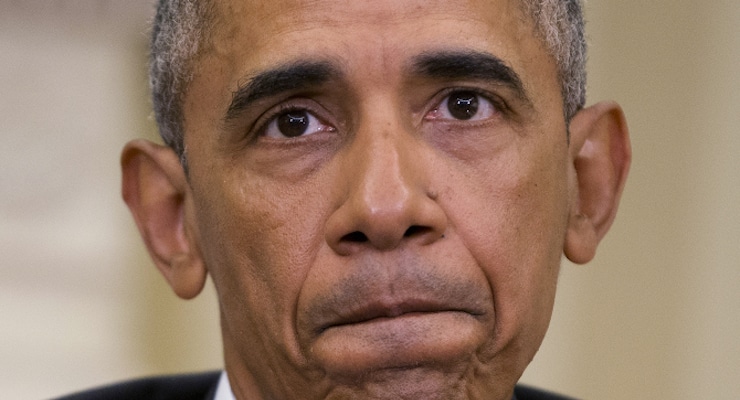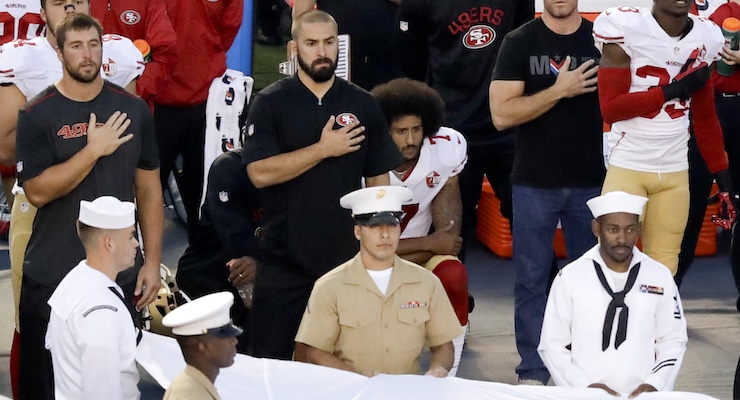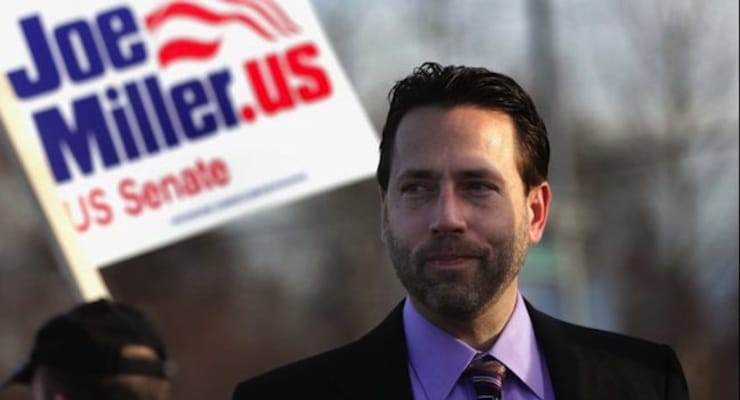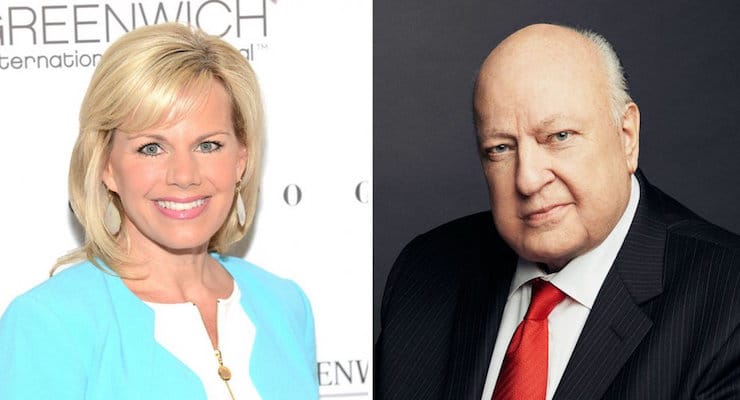The Obama Administration’s Assault on the Rule of Law

President Barack Obama pauses while speaking to members of the media in the Oval Office of the White House in Washington on Monday, June 13, 2016. (Photo: AP/Pablo Martinez Monsivais)
What’s the worst development in economic policy of the Obama years?
- The faux stimulus scheme?
- The Obamacare boondoggle?
- The fiscal cliff tax hike?
- The Dodd-Frank bailout bill?
Those are all good answers, but if you look at the data from Economic Freedom of the World, a major reason for the decline in America’s score is that the rule of law has eroded.
In other words, the United States is becoming a place where clear and neutral rules are being replaced by arbitrary and capricious government power. And this is not a trivial matter. Issues related to the rule of law account for 20 percent of a nation’s grade – the same level of importance as fiscal policy.
 In another worrisome development, the United States only ranked #19 as of 2014 in a global ranking of how well nations maintain the rule of law.
In another worrisome development, the United States only ranked #19 as of 2014 in a global ranking of how well nations maintain the rule of law.
There are several reasons why America’s ranking is going down. To cite just a few: The arbitrary rewrites of Obamacare. The Operation Chokepoint fiasco. IRS regulations that overturn existing law.
And it appears the Obama Administration wants to go out with a bang.
The Wall Street Journal opines on a new regulatory scheme from the Treasury Department to boost the death tax burden by arbitrarily inflating the value of certain assets.
…before President Obama leaves office, his Treasury Department is rushing to implement a de facto increase in the federal estate tax. Since Congress does not agree that the Internal Revenue Service should suck more cash out of family firms, Treasury Secretary Jack Lew is up to his usual tricks, trashing established interpretations of tax law to bypass the legislative branch. Not even Mr. Lew has the gall to claim he can raise the federal death-tax rate of 40% without congressional approval. So the game here is to contrive ways to expose more of the value—or imagined value—of an estate to IRS revenue collectors. Last month Mr. Lew’s Treasury announced a proposed rule to close what it calls an estate and gift tax “loophole.” Until now, the IRS permitted realistic values for portions of closely held corporations and partnerships. …consider a minority stake with limited rights in a family business. While the business as a whole may have considerable value, how much would an investor be willing to pay for a small, illiquid piece of a private business that she can’t control? The typical answer is not much. On the other hand, the investor might pay handsomely for a controlling interest. The IRS has long recognized this reality and has allowed the discounting of interests in closely held businesses to more closely reflect what they could fetch on the open market, rather than simply assigning a percentage of a firm’s overall estimated value.
In other words, Obama’s Treasury Department wants to force heirs to pay tax on what  they think an asset is worth rather than what it would fetch on the open market.
they think an asset is worth rather than what it would fetch on the open market.
This regulatory scheme – if ultimately successful – will make a bad tax even worse.
And it also will be bad for the economy.
…what seems like a reasonable interpretation to some looks like a wasted revenue opportunity to the Obama Treasury. …As always, Mr. Lew and Treasury are happy to seize more wealth from the private economy. …But voters may ask how much economic destruction is acceptable in the name of such fairness. …the tax clearly encourages people to consume now rather than invest in the future. This means lower GDP over time and fewer opportunities for the poor, some of whom might want to work for family businesses. The Tax Foundation reckons that the economy would be 0.8% larger over a decade without the estate tax.
Here’s another example.
The Obama Administration has been shaking down banks for money because of supposed misdeeds leading up the government-caused financial crisis.
The various fines may of may not be legitimate, but what’s really troubling is that a big chunk of the money is then being steered to left-wing groups. Many of which are seeking to impact the political process.
Andy Koenig of Freedom Partners has a column in the Wall Street Journal with some of the unseemly details.
The administration’s multiyear campaign against the banking industry has quietly steered money to organizations and politicians who are working to ensure liberal policy and political victories at every level of government. The conduit for this funding is the Residential Mortgage-Backed Securities Working Group, a coalition of federal and state regulators and prosecutors created in 2012 to “identify, investigate, and prosecute instances of wrongdoing” in the residential mortgage-backed securities market. In conjunction with the Justice Department, the RMBS Working Group has reached multibillion-dollar settlements with essentially every major bank in America. …Combined, the banks must divert well over $11 billion into “consumer relief,” which is supposed to benefit homeowners harmed during the Great Recession. …a substantial portion is allocated to private, nonprofit organizations drawn from a federally approved list. Some groups on the list—Catholic Charities, for instance—are relatively nonpolitical. Others—La Raza, the National Urban League, the National Community Reinvestment Coalition and more—are anything but. This is a handout to the administration’s allies. Many of these groups engage in voter registration, community organizing and lobbying on liberal policy priorities at every level of government. They also provide grants to other liberal groups not eligible for payouts under the settlements. …The settlements also give banks a financial incentive to fund these groups. Most of the deals give double credit or more against the settlement amount for every dollar in “donations.”
Needless to say, diverting money to political allies sounds like the kind of chicanery you’d find in a banana republic, not an advanced western society.
But it gets worse.
Here’s another Wall Street Journal editorial on an additional bit of regulatory/tax overreach by the Treasury Department. It deals with the Obama Administration trying to stop “inversions” by unilaterally changing the rules in ways that will hamper sensible business practices for all multinational companies.
The Treasury Secretary…wants to prevent “earnings stripping,” in which companies allegedly make loans from their overseas businesses to their U.S. subsidiaries to minimize taxes. The feds succeeded in destroying the proposed merger of Pfizer and Allergan. But we warned in April that the Treasury plan would be “ugly for everybody,” imposing new costs and paperwork burdens on companies that never had any intention of moving overseas or stripping earnings. And sure enough, from small S corps all the way to Exxon, the afflicted have been explaining how the new rules will make it more expensive and difficult to do even routine business functions like cash management. …the banks hate this rule too. By limiting their ability to move money across borders to meet customer demand and respond to market stress, it could force them to violate other regulations, or worse. A July letter from Citigroup, Bank of America and J.P. Morgan Chase to Treasury officials warned the rules could make “financial services groups more fragile in times of financial stress, thereby creating risk to the financial stability of the United States.” …If Mr. Lew were reasonable, he’d drop this misguided assault on American business and work with lawmakers to craft a corporate tax reform that ensures U.S. companies never want to leave the U.S.
A report in the New York Times highlighted some of the legal issues involved in this issue.
The U.S. Chamber of Commerce filed a lawsuit on Thursday to block new rules issued by the Obama administration that prevent American corporations from merging with foreign-based companies and moving their headquarters abroad to save on taxes. The business group, along with the Texas Association of Business, filed the lawsuit in federal court in Austin, Tex., saying the administration was overstepping its authority in issuing the rules. …“If the defendants’ rule is permitted to stand, it is not just mergers that will suffer — it is the rule of law, and the certainty and stability required for effective commerce, markets and economic growth, that are truly threatened by the defendants’ unauthorized and unlawful action,” the plaintiffs said in their filing. …“Although it might seem esoteric, this action is a clear case of federal executive branch officers and agencies bypassing Congress and short-circuiting legislative debate over a hotly contested issue,” the lawsuit says.
Ugh. At least Hillary Clinton is proposing to change the law in pursuit of bad policy on inversions. Obama just waves his magic wand.
Let’s wrap up by refocusing on why the rule of law is a fundamental building block of a free society. Back in 2014, I shared a very good video from Learn Liberty about the importance of the rule of law.
That video is a compelling explanation of why it is good to have clear rules, along with limits on the arbitrary power of government officials.
Indeed, it’s probably no exaggeration to assert that rule of law is the greatest contribution of western civilization.
Here’s a movie clip (courtesy of FEE) that makes this point.
Based on the Obama Administration’s unilateral and capricious actions, maybe a new movie should be made about the rise and decline of western civilization.
P.S. On the topic of Obama and movies, here’s some humor to offset today’s dismal topic.
It’s no exaggeration to assert that rule


































